 The 18 megapixel Canon EOS 600D (called the Digital Rebel T3i in North America) is a new DSLR camera that sits above last year’s 550D / T2i at the top of Canon’s entry-level EOS line-up. The 600D / T3i offers a 1,040,000-dot vari-angle LCD screen, a 63-zone metering sensor - identical to the one used in the more expensive EOS 7D - standard ISO settings of 100-6400 (expandable to 12800), and 3.7fps continuous shooting. The 600D’s video mode features 1080p Full HD recording at 24/25/30fps and 720p HD capture at either 50 or 60fps, with full manual control over exposure and gain. The Canon EOS 600D / T3i is priced at £679.00/€819.00/$799.99 for the body only, £769.00/€929.00/$899.99 with the new EF-S 18-55mm f/3.5-5.6 IS II lens, and £949.00/€1,149.00/$1099.99 with the 18-135mm f/3.5-5.6 IS lens.
The 18 megapixel Canon EOS 600D (called the Digital Rebel T3i in North America) is a new DSLR camera that sits above last year’s 550D / T2i at the top of Canon’s entry-level EOS line-up. The 600D / T3i offers a 1,040,000-dot vari-angle LCD screen, a 63-zone metering sensor - identical to the one used in the more expensive EOS 7D - standard ISO settings of 100-6400 (expandable to 12800), and 3.7fps continuous shooting. The 600D’s video mode features 1080p Full HD recording at 24/25/30fps and 720p HD capture at either 50 or 60fps, with full manual control over exposure and gain. The Canon EOS 600D / T3i is priced at £679.00/€819.00/$799.99 for the body only, £769.00/€929.00/$899.99 with the new EF-S 18-55mm f/3.5-5.6 IS II lens, and £949.00/€1,149.00/$1099.99 with the 18-135mm f/3.5-5.6 IS lens.Ease of Use
Outwardly, the Canon EOS 600D / Rebel T3i is virtually identical its predecessor, with a few tweaks to accomodate the new vari-angle LCD screen. It is a fairly small camera with a largely plastic shell and a pretty narrow, mildly uncomfortable hand-grip. The emphasis is on the word "mildly", though - in actual use, the size and shape of the grip proved not to be too much of an annoyance. In terms of build quality, the Canon EOS 600D / T3i certainly feels solid enough for a consumer-grade DSLR, although not in the same league as the semi-professional EOS 60D and 7D models. Like all of Canon's APS-C digital SLR cameras, the EOS 600D / T3i is compatible with the manufacturer's entire line-up of lenses, including both EF and EF-S glass. When changing lenses, EF lenses need to be aligned with the red dot on the lens mount, whereas EF-S lenses must be aligned with the white mark.
Most of the controls are in the same place as on the 550D, with the changes being mostly cosmetic in nature. The Display button has moved next to the ISO button on top of the camera to make way for the new Info button on the rear. The shape of some buttons and the rear thumb-grip area have also changed somewhat to allow the LCD screen to be pulled out, while the controls on the left-hand side of the 600D (viewed from the rear) have been split into two to accomodate the side-mounted hinge for the screen. All of the buttons are clearly labelled but, being flush to the body, can be a little hard to press at times.
The 1,040,000-dot resolution of the rear LCD panel may not sound like a lot more than the 920,000 dots of the older 500D's display, but given that the screen has an aspect ratio of 3:2 - i.e. identical to that of the sensor - the photos fill the screen completely, with no black stripes along the top and bottom. More importantly the 60D is the second EOS DSLR to feature an articulated screen. It's taken quite some time for Canon to realise that the full potential of Live View and video shooting can only be exploited if it's delivered on a hinged screen, but it makes perfect sense on the consumer-oriented 600D. In terms of flexibility, Canon's left-hinged, free-angle monitor is on a par with those offered by Olympus and Panasonic, and significantly more flexible with those found on Sony and Nikon DSLRs. The high-res, free-angle LCD screen is much more than just a novelty - it's a lot more versatile than the usual combination of optical viewfinder and fixed LCD, providing new angles of view and enhancing your overall creativity. Above all, it's a fun way of composing your images.
We tested the EOS 600D with the new EF-S 18-55mm f/3.5-5.6 IS II lens, which offers a fairly standard focal range for a kit lens and crucially includes image stabilisation. This is important for Canon, as competitors like Sony, Olympus and Pentax all offer image stabilisation in their DSLRs. The difference between Canon (and Nikon) and the others is that Sony, Olympus and Pentax have opted for stabilisation via the camera body, rather than the lens, which therefore works with their entire range of lenses. Canon's system is obviously limited by which lenses you choose, but it does offer the slight advantage of showing the stabilising effect through the viewfinder. Canon and Nikon also claim that a lens-based anti-shake system is inherently better too, but the jury's out on that one.
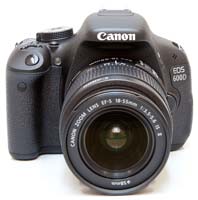 | 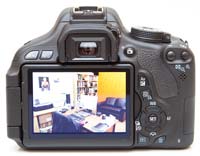 |
| Front | Rear |
The EOS 600D's top-mounted shooting mode dial has a multitude of letters and icons. The so-called Creative Zone features Programmed Auto (P), Shutter Priority (Tv), Aperture Priority (Av), Manual (M) and A-DEP modes. The first four of these need no explanation, but A-DEP might be new to those who have never used a Canon SLR camera before. The abbreviation stands for Automatic Depth of Field, as in this mode, the camera will pick an f-stop that allows all the subjects covered by the nine AF points to be sharply rendered, and will also calculate and set the necessary shutter speed on its own.
The new fully-automatic Scene Intelligent Auto mode replaces the 550D's Full Auto mode, analysing the scene in front of you and automatically picking the best settings, much like the systems used by lot of digital compacts. Also reflecting its more consumer-friendly nature, the 600D offers a number of creative filters, as previously seen on Canon's range of compact cameras. Soft Focus dramatizes an image and smooths over any shiny reflections, Grainy Black and White creates that timeless look, Toy Camera adds vignetting and color shift, and Miniature Effect makes a scene appear like a small-scale model, simulating the look from a tilt-shift lens. All of these filters can be applied to both JPEG and RAW files either before or after taking the picture.
The camera also has a Creative Auto mode which is targeted at beginners who have grown out of using the Scene Intelligent Auto mode, allowing you to change a few key settings using the LCD screen via a simple slider system for changing the aperture and exposure compensation, or Background and Exposure as the camera refers to them. Creative Auto has been extended with the introduction of Basic +. Essentially a more extreme version of the well-established Picture Styles, this offers nine options including Standard, Vivid, Soft, Warm, Intense, Cool, Brighter, Darker and Monochrome, all of which can be interactively tweaked to suit your taste.
There's a host of scene modes including Flash Off, Portrait, Landscape, Sports, Night Portrait and, oddly enough for an interchangeable-lens camera, a close-up mode as well. The majority of these scene modes allow users who do not want to fiddle with shutter speeds, f-stops, white balance or ISO settings to let the camera know what type of photo they are about to take, which helps the EOS 600D / T3i to optimise these settings for that particular subject. We struggled to see the point of the close-up mode though, as the quality of one's close-up shots depends more on the use of the right kinds of accessory - such as a macro lens and possibly a ring flash - than any camera setting. The new Feature Guide in the EOS 600D’s menu system usefully provides a brief description of each setting and its effect.
 | 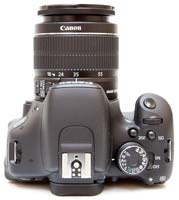 |
| Front | Top |
Reflecting its more consumer-friendly nature, the 600D offers a number of creative filters, as previously seen on Canon's range of compact cameras. Soft Focus dramatizes an image and smooths over any shiny reflections, Grainy Black and White creates that timeless look, Fish-eye mimics the distortion provided by an expensive fish-eye lens, Toy Camera adds vignetting and color shift, and Miniature Effect makes a scene appear like a small-scale model, simulating the look from a tilt-shift lens. All of these filters can be applied to both JPEG and RAW files either before or after taking the picture.
In the Creative Zone, the photographer gets to set a lot of shooting variables, including white balance, sensitivity, AF mode, exposure compensation, drive mode and so on. Most of these functions have their own dedicated buttons - ISO on the top panel, the rest on the back - while others can be set on the interactive status screen accessible via the Q (quick control) button. Examples for the latter include file quality settings, metering mode, flash exposure compensation and Auto Lighting Optimiser.
The available white balance settings are Auto, Daylight, Shade, Cloudy, Tungsten, Fluorescent and Custom; there is no way to enter a Kelvin value manually. You can fine-tune any of the presets using the White Balance Correction feature. The ISO speed can be changed by pressing the ISO button and turning the control wheel in front of it. You do not have to hold down the button while turning the wheel. The ISO speed can be set from ISO 100 to ISO 6,400 in full-stop increments. If you turn ISO Expansion on in the Custom Functions menu, you can even dial in ISO 12,800; a boosted setting. Auto ISO is also available. The chosen ISO speed is also displayed in the viewfinder.
The EOS 600D / T3i offers a range of three auto focus modes (One Shot, AI Focus and AI Servo) and there's a 9-point AF module with a cross-type centre point and eight line-type AF sensors. One Shot AF is equivalent to AF-S, while AI Servo is the same thing as AF-C on other manufacturers' models. AI Focus is similar to what some other camera makers call AF-A in that it automatically switches from One Shot AF to AI Servo if a still subject starts moving. As regards AF point selection, it can be done manually by hitting the AF point selector button first, then using the four-way controller to select the AF point. The chosen/active AF point lights up in red in the viewfinder. In use, we have found the AF system to be pretty quick even with the kit lens, although the focus motor was a bit loud for our tastes (not surprisingly, given that the 18-55mm IS lens does not have USM).
There are a number of drive modes available on the Canon EOS 600D / T3i. These include Single Shot, Continuous Shooting, Self-timer and Remote Controlled Shooting. In Continuous Shooting mode, the camera can take pictures at a speed of 3.7 frames per second for up to 34 Large Fine JPEGs or 6 raw files. This is identical to the EOS 550D but much slower than the 8fps of the 7D - which is no wonder given that the 7D has two Digic 4 processors, while the 600D / T3i has only one.
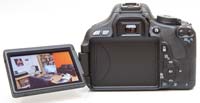 | 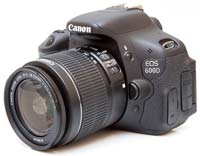 |
| Rotating LCD Screen | Side |
The metering modes offered by the camera include Centre-weighted, Evaluative, Partial and Spot. The difference between Partial and Spot metering is that the former uses 9% of the frame area, whereas the latter uses only 4% (still a bit too much for spot metering, but there you go). Both of these selective metering modes are midtone-based; there is no highlight- or shadow-based spot metering available as with some rivals. In use, we've found that the Evaluative metering mode provided fairly good exposures with a variety of subjects, thanks to the advanced 63-zone metering sensor. When shooting contrasty scenes, it is worth using the Evaluative mode in conjunction with the Auto Lighting Optimiser feature, accessible by hitting the Q button and using the interactive status panel.
The Live View button is within easy reach of your right thumb. Using this button it is easy to enter Live View, but it takes a surprising amount of time for the camera to actually display the live image (think several seconds). A grid line display and very useful live histogram can be enabled to help with composition and exposure, and you can zoom in by up to 10x magnification of the image displayed on the LCD screen. Focusing in Live View has been simplified, you no longer need to use the * button to initiate auto focus but can use a half-press of the shutter release as normal.
There are three auto focus options in Live View, including Quick, Live and Face Detection. The use of the Quick mode briefly interrupts the live view feed as the mirror is momentarily lowered so that the AF sensors can be engaged, and it also involves a lot of mirror slapping for the same reason. Live view mode circumvents this problem by employing a contrast-detect method. While this is slower, and sometimes it may still take up to three seconds for the camera to lock focus in this mode, I have found that about half a second was enough most of the time. This is still too slow for anything that moves - use the optical finder and the regular auto focus module for that type of shooting - but it is perfectly OK with still subjects. Obviously, you can also opt to focus manually - the large and high-res screen is a real boon to those who do this on a regular basis. As noted above, you can even magnify into the live image, by up to 10x, which allows very accurate focusing.
Live View is also used for the Canon EOS 600D / T3i's movie mode. If you turn the mode dial to the position denoted by the movie camera icon, the camera will enter Live View automatically. Before you start filming, you need to focus on the subject either manually or using auto focus as described above, and optionally set exposure and ISO. To be able to do this, you first need to enter the menu, highlight "Movie exposure" on the relevant tab, and select "Manual". Now you can set aperture, shutter speed (within limits) and ISO manually. Note that even if you do not enable manual exposure for movies, you can still use functions like AE lock and exposure compensation if you feel a need for it.
Once everything is set up, you start filming by hitting the Live View/Record button on the back of the camera. The EOS 600D / T3i will not automatically adjust focus during filming, but you can initiate auto focus at any time while recording a clip. However, be warned that this can do more harm than good, as the microphone can pick up the sound of the focus motor, and the subject might even go out of focus for a few seconds. Setting a small aperture and relying on depth of field for focus is a better idea. Of course you may wish to utilise the DSLR's ability to produce footage with a shallow depth of field, but in that case, it might be a wise idea to purchase a couple of third-party accessories that make manual focusing and focus pulling easier.
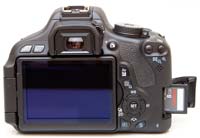 | 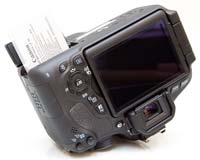 |
| Memory Card Slot | Battery Compartment |
The EOS 600D has a large choice of frame rates, offering a choice of 24, 25 or 30fps when recording Full HD video clips, and 50/60fps when shooting at 720p or VGA resolution. Note however that the available frame rates are also dependent on what you have set in the menu under "Video system": NTSC or PAL. Another novelty of the EOS 600D / T3i is that if you shoot a standard-definition clip, you can use a function called "Movie crop". This means that you can tell the camera to use only the central 640×480 pixels on the sensor to record video, which effectively gives you nearly 10x magnification. This can come in handy when you do not have the necessary telephoto reach to film something that is happening at a distance.
The EOS 600D's built-in pop-up flash now features a built-in Integrated Speedlite Transmitter for controlling up to two groups of off-camera Speedlites without the need for an external transmitter. Note that it doesn't have a more advanced PC Sync port for connecting the camera to external lights, limiting the 600Ds use in studio environments. There's also the expected hotshoe for use with one of Canon's external flashguns.
There is a built-in microphone for mono recording, and you can connect an external microphone equipped with a stereo mini plug to the camera's external microphone IN terminal. The new Video Snapshot feature allows short clips of 2, 4 or 8 sec to be merged into a single movie file, for footage that is short, easy to edit and of similar lengths to the clips used in most TV programmes. The clips are saved to a Video Snapshot Album and you can even add a soundtrack in-camera.
The camera runs on a proprietary LP-E8 battery which, according to measurements that conform with CIPA standards, provides enough power for 400-440 images when using the optical viewfinder, and about 150-180 shots with Live View or about one and a half hours of video recording. The battery can be charged in the supplied LC-E8(E) charger. Also in the box is a neck strap, a software CD and a user manual, which Canon thankfully provides in printed form, in several languages.
In use, we found the Canon EOS 600D / Rebel T3i to be a responsive and versatile camera that almost never got in the way of picture taking. As noted earlier, the auto focus was fast when using the optical viewfinder, and not always painstakingly slow when using Live View, either. Its continuous shooting speed is about average for its class, though its six-frame raw buffer is smaller than we'd like. It takes a bit of time for the camera to fully start up if you wait for the sensor cleaning cycle to be completed, but as sensor cleaning can always be interrupted at a half-press of the shutter release, this is not a real issue. The only thing we found to be truly and somewhat inexplicably slow was entering Live View - it invariably took several seconds for the camera to raise its mirror and display the live image.
This concludes our evaluation of the EOS 600D's ergonomics, handling, feature set and performance. Let's take a look at its Image Qality ne


 Wednesday, March 23, 2011
Wednesday, March 23, 2011

 Posted in:
Posted in:
0 comments:
Post a Comment